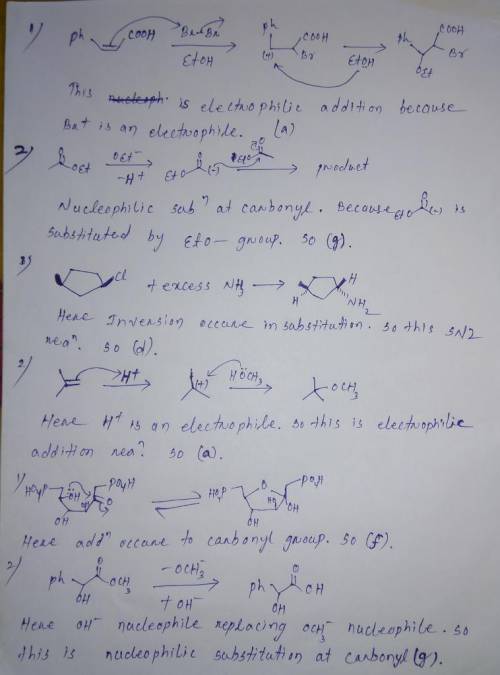
Chemistry, 05.05.2020 04:46 velazquez2974
. 2. a = Electrophilic addition d = SN2 Nucleophilic substitution g = Nucleophilic subs at carbonyl(acyl Xfer) b = E2 Elimination e= Electrophilic aromatic substitution h = Conjugate (nucleophilic) addn c = SN1 Nucleophilic substitution f = Carbonyl nucleophilic addn Identify the mechanism by which each of the reactions above proceeds from among the mechanisms listed. Use the letters a - i for your answers.

Answers: 3


Another question on Chemistry


Chemistry, 22.06.2019 16:00
Click the button that shows the correct relationship of the electron affinities of the elements sodium and phosphorus. sodium’s electron affinity value is more negative than the electron affinity value of phosphorus. phosphorus’ electron affinity value is more negative than the electron affinity value of sodium. this information cannot be determined using the periodic table. answer is b on e2020.
Answers: 3

Chemistry, 23.06.2019 09:50
T(s) in2os] (m) 0 185 2.39 546 1.90 725 1.70 the decomposition of n205 can be described by the equation 2.68 given these data for the reaction at 45°c in carbon tetrachloride solution, calculate the average rate of reaction for each successive time interval. ntr s to 185 s 185 s to 546 s 546 s to 725 s number number number reaction rate: m/s m/s m/s
Answers: 1

Chemistry, 23.06.2019 10:10
Calculate the h3o+ concentration in a solution of acetic acid if the concentration of molecular acetic acid present at equilibrium is 9.97x10-3 m and k for the dissociation is 1.86x10-5. ch3cooh(aq)+h2o(l)+> h3o+(aq)+ch3coo-(aq) show me how to get the answer.
Answers: 3
You know the right answer?
. 2. a = Electrophilic addition d = SN2 Nucleophilic substitution g = Nucleophilic subs at carbonyl(...
Questions



Physics, 06.10.2019 04:30




Computers and Technology, 06.10.2019 04:30

Mathematics, 06.10.2019 04:30







Computers and Technology, 06.10.2019 04:30








